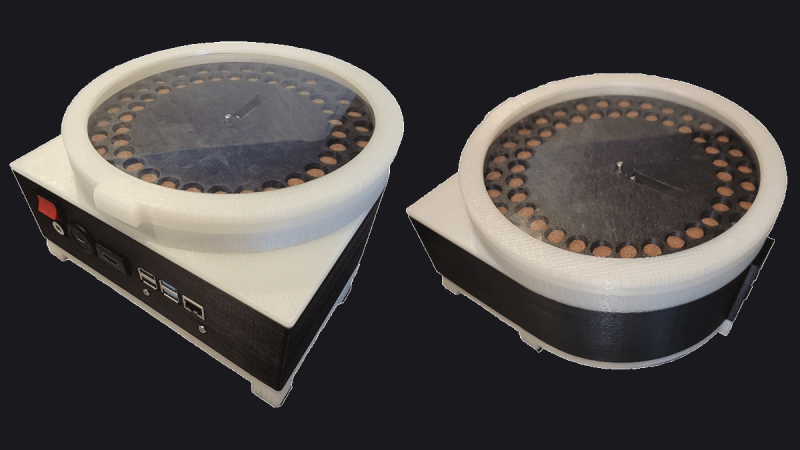The principles of open-source hardware are starting to make great strides in scientific research fields. [Walker Arce] tells us about his paper co-authored with [Jeffrey R. Stevens], about a dog treat dispenser designed with scientific researchers in mind – indispensable for behavior research purposes, and easily reproducible so that our science can be, too. Use of Raspberry Pi, NEMA steppers and a whole lot of 3D printed parts make this build cheap (< $200 USD) and easy to repeat for any experiments involving dogs or other treat-loving animals.
Even if you’re not a scientist, you could always build one for your own pet training purposes – this design is that simple and easy to reproduce! The majority of the parts are hobbyist-grade, and chances are, you can find most of the parts for this around your workshop. Wondering how this dispenser works, and most importantly, if the dogs are satisfied with it? Check out a short demonstration video after the break.
Despite such dispensers being commercially available, having a new kind of dispenser designed and verified is more valuable than you’d expect – authors report that, in their experience, off-the-shelf dispensers have 20-30% error rate while theirs can boast just 4%, and they have test results to back that up. We can’t help but be happy that the better-performing one is available for any of us to build. The GitHub repository has everything you could want – from STLs and PCB files, to a Raspberry Pi SD card image and a 14-page assembly and setup guide PDF.
Open hardware and science are a match made in heaven, even if the relationship is still developing. The Hackaday community has come together to discuss open hardware in science before, and every now and then, open-source scientific equipment graces our pages, just like this recent assortment of biosensing hacks using repurposed consumer-grade equipment.

















The 1960s through 80a shudders in horror at so much processing power wasted when a mechanical mechanism can do the same.
Unless this has encrypted QR on the back of that disk to verify and track every treat, and a line of break beams to verify accidental double treat or no treat failures (why is it only 4% accurate with the I/O and processing power to run a bank of test equipment?)
Maybe its also running the test simulation screen?
Gaaaaaah.
But yes, a hack
I see . . . .
Direct connected to a stepper motor shaft, not a fan of that personally, could have geared it and used a sensor to stop it precisely
Treat machine for small dogs or just well-behaved ones. I know a Doberman that would be gnawing his way through the plastic housing in seconds.
I wondered myself if the clear lid would allow smarter animals to know how many treats were there.
But it does seem they hide this in a wall, so no access to the unit.
One of my cats would likely be 15-20 kg if I offered such a device. I have thought about a chip reader to manage daily diet though; could possibly save the 05:00 “wake-up and feed me” paw on my face…
Combine a timed automated feeder with selectable portions with bark detection used to trigger a soothing high fidelity owner voice playback as done with the clever device covered here a while ago and you’d have a huge commercial success IMO.
the video reminds me of the plans to make a pigeon controlled guide bomb…
https://en.wikipedia.org/wiki/Project_Pigeon
I don’t believe the term “NEMA steppers” convey any useful information. No size designation – it could be anything.
Funnel shaped hopper into which is poured the treats. 3D printed “shutter” with a cylindrical hole in it which will hold two treats placed at the base of the funnel. Move it via a servo or stepper motor over a hole which will release the two treats. Move back and repeat. Simpler?
This is a classic example of over-engineering in the extreme. I have a stupid $5 fish feeder which is a motor with a timer that dumps a hopper on a schedule. If their off the shelf dispenser has a 20% error rate, they need a new supplier for sure. Did they ever hear of a gumball machine? I bet this research was done on a government grant.
Unlike dog treats, fish food is granular and gumballs are hard and spherical.
Personally I have purchased 3 different automatic feeders over $100. I can confirm the 20% error rate… actually 20% seems to low, they fail far more often. Food always gets stuck in the mechanisms, the motors and firmware have no detection for stuck food and no way of knowing if food has actually come out. Replacing the guts of one has been on my to do list for a while. Wouldn’t be hard to add a sensor and give the motor the ability to reverse to get stuck food out… or a higher torque motor to break stuck food.
Problem is that these are made cheaply.